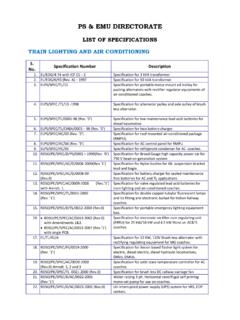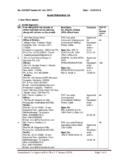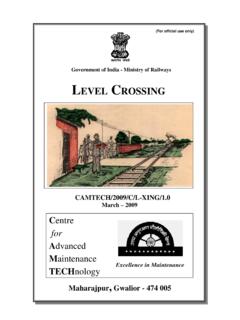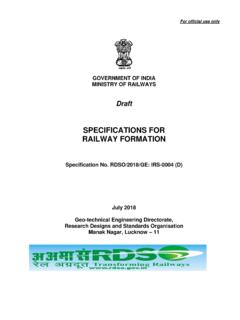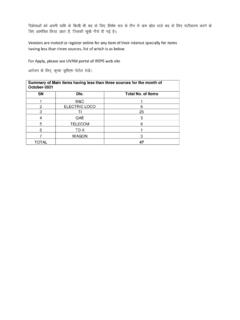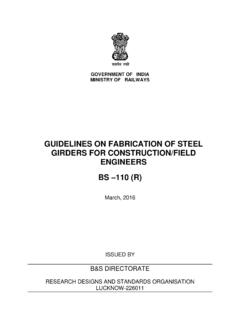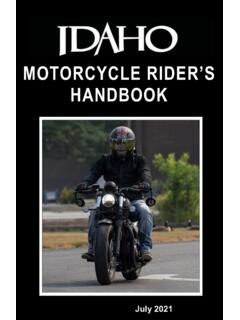Transcription of An Introductory Handbook on Communications Based Train ...
1 GOVERNMENT OF INDIA. MINISTRY OF RAILWAYS. An Introductory Handbook on Communications Based Train Control (CBTC). End Users: Indian Railways Signal Engineers CAMTECH/S/PROJ/2020-21/SP9 February 2021. INDIAN RAILWAYS. Centre for Advanced Maintenance Technology Maharajpur, Gwalior ( ) Pin Code 474 005. i This page has been left blank intentionally ii Introductory Handbook on Communications Based Train Control (CBTC). CAMTECH/S/PROJ/2020-21/SP9 February 2021. iii This page has been left blank intentionally iv Foreword Conventional railway signalling is Based on colour light signals and Train detection with the help of track circuits and axle counters. Although this technology is suitable for detection and control of trains it is still not able to utilize the section capacity to its full advantage.
2 Over the last decade, railways have seen a huge transition from conventional railway signalling systems to modern signalling systems. As there are continuous improvements in technology, we need to keep pace with the latest trends and keep ourselves updated. Communications - Based Train Control (CBTC) is a modern communication- Based system that uses radio communication to transfer timely and accurate Train control information. CBTC is the choice of mass-transit railway operators today, with over a hundred systems currently installed worldwide. In India also, the CBTC technology is finding applications in Metro railways. CAMTECH has issued this Introductory Handbook for Signal &. Telecommunication engineers to get them acquainted with the technology used in CBTC and help them in implementing the system suitable for Indian Railways.
3 As this is a new technology, the information given in this Handbook is generic, which will be subsequently revised after gaining further experience. I hope that this Handbook will be helpful to S&T engineers of Indian Railways at least in understanding the concept of CBTC. I wish them all the success. CAMTECH Gwalior Jitendra Singh Date: Principal Executive Director v This page has been left blank intentionally vi Preface Trains are mostly worked on Absolute Block system or Automatic Block system over Indian Railways which have fixed length blocks. These systems maintain unutilized space between two trains running in the same direction. To utilize the track to its maximum capacity, modern communication Based systems are used in some countries. CBTC is one such modern, radio communication- Based signalling system which enables high resolution and real- time Train control information, which increases the line capacity by safely reducing the distance (headway) between trains travelling on the same line, and minimizes the numbers of trackside equipment.
4 CBTC is being introduced on Metro Railways in India. Each Metro is using different communication technology such as LTE, GSM-R, TETRA etc. with different detection devices and interlocking as standby, hence their method of operation may vary slightly from one system to another. CAMTECH has prepared this Handbook to help S&T engineers in understanding the concept of CBTC. A case study of Kolkata Metro is also added to get a better idea of the subject. We are sincerely thankful to Metro Railway, Kolkata and M/s Efftronics System Pvt. Ltd., Vijayawada, who helped us in preparing this Handbook . Since technological up-gradation and learning is a continuous process, you may feel the need for some addition/modification in this Handbook . If so, please give your comments on email address or write to us at Indian Railways Centre for Advanced Maintenance Technology, In front of Adityaz Hotel, Airport Road, Near DD Nagar, Maharajpur, Gwalior ( ).
5 474005. CAMTECH Gwalior Dinesh Kumar Kalame Date: Director (S&T). vii This page has been left blank intentionally viii Table of Contents iv Preface .. vi Table of Contents .. viii Issue of correction slips .. x xi Our Objective .. xii CAMTECH xiii Abbreviations ..xiv List of Figures ..xvi List of Tables ..xvii Terms & Definitions .. xviii Chapter I .. 1. Control over movement of trains .. 1. Introduction .. 1. Conventional methods of Train 1. Absolute Block System .. 2. Intermediate Block Signalling (IBS) System .. 2. Automatic Block Signalling (ABS) System .. 3. Cab Signalling .. 6. Centralized Traffic Control (CTC) System .. 7. Need for a Train control system utilizing maximum track space .. 7. Chapter II .. 9. Communications Based Train Control (CBTC)-A moving Block Signalling concept.
6 9. Introduction .. 9. CBTC System Design .. 11. Control of Train movement through CBTC .. 14. Moving Block Principle .. 14. Determination of Train location in 16. Communication arrangements in CBTC .. 16. Train Operating Modes .. 23. Performance requirements of CBTC as per IEEE 25. ix Functional Requirements of CBTC as per IEEE 27. ATP functions .. 27. ATO functions .. 31. ATS functions .. 31. User Interface Requirements of CBTC as per IEEE .. 33. Operations related user interface requirements Train -borne subsystems .. 33. Train -borne subsystems 34. Operations related user interface requirements non- Train -borne subsystems .. 36. Maintenance-related user interface requirements .. 36. Chapter III .. 38. Applications of CBTC in Mass 38. Metro trains using CBTC technology.
7 38. Metros with CBTC in India .. 39. India's first driverless Train on Delhi Metro - A new beginning .. 41. Comparison between parameters of Mainline Railway and Metro Railway .. 43. Chapter 44. Kolkata East-West Metro Line 2 with CBTC Technology A case 44. Introduction .. 44. Functioning of CBTC .. 45. Signalling assets .. 46. Telecom Assets .. 51. List of Signalling Assets at E-W Metro Corridor .. 53. List of Telecom Assets at E-W Metro Corridor .. 55. Building Requirements .. 57. Annexure .. 58. Metro Railways General Rules 2013 .. 58. & .. 58. Opening of Metro Railways for Public Carriage of Passengers Rules .. 58. 2013 .. 58. References .. 64. x Issue of correction slips The correction slips to be issued in future for this report will be numbered as follows: CAMTECH/S/PROJ/2020-21/SP9 # XX date.
8 Where XX is the serial number of the concerned correction slip (starting from 01. onwards). CORRECTION SLIPS ISSUED. Sr. No. of Date of issue Page no. and Item Remarks Correction No. modified Slip xi Disclaimer It is clarified that the information given in this Handbook does not supersede any existing provisions laid down in the Signal Engineering Manual, Railway Board and RDSO publications. This document is not statuary and instructions given are for the purpose of guidance only. If at any point contradiction is observed, then Signal Engineering Manual, Telecom Engineering Manual Railway Board/RDSO guidelines may be referred or prevalent Zonal Railways instructions may be followed. xii Our Objective To upgrade Maintenance Technologies and Methodologies and achieve improvement in Productivity and Performance of all Railway assets and manpower which inter-alia would cover Reliability, Availability and Utilisation.
9 If you have any suggestion & any specific comments, please write to us: Contact person : Director (Signal & Telecommunication). Postal Address : Centre for Advanced Maintenance Technology, Maharajpur, Gwalior ( ) Pin Code 474 005. Phone : 0751 - 2470185. Fax : 0751 2470841. Email : xiii CAMTECH Publications CAMTECH is continuing its efforts in the documentation and up-gradation of information on maintenance practices of Signalling & Telecom assets. Over the years a large number of publications on Signalling & Telecom subjects have been prepared in the form of handbooks, pocket books, pamphlets and video films. These publications have been uploaded on the internet as well as railnet. For downloading these publications On Internet: Visit Go to Directorates CAMTECH Gwalior Other Important links Publications for download - S&T Engineering or click on link ,2,17,6313,6321,6326.
10 On Railnet: Visit RDSO website at Go to Directorates CAMTECH Publications S&T Engineering Or click on the link A limited number of publications in hard copy are also available in CAMTECH library which can be got issued by deputing staff with official letter from controllong officer. The letter should be addressed to Director (S&T), CAMTECH, Gwalior. For any further information regarding publications please contact: Director (S&T) 0751-2470185 (O)(BSNL). SSE/Signal - 7024141046 (CUG). Or Email at Or FAX to 0751-2470841 (BSNL). Or Write at Director (S&T). Indian Railways Centre for Advanced Maintenance Technology, In front of Hotel Adityaz, Airport Road, Maharajpur, Gwalior ( ) 474005. xiv Abbreviations Abbreviation Description ABS Automatic Block Signalling ACS Access Control System ATC Automatic Train Control ATO Automatic Train Operation ATP Automatic Train Protection ATS Automatic Train Supervision BBRS Backbone Routers BCC Backup Control Centre BO Block Overlap BTM Balise Transmission Module BTS Base Tranceiver Station CBTC Communications Based Train Control CC Carborne Controller CCTV Closed Circuit Television CBI Computer Based Interlocking CSS Customer Switching System CTC Centralized Traffic Control DCS Data Communication System DMRC Delhi Metro Rail Corporation DSLD Double Sided Low Density DTO Driverless Train Operation FSS First Stop Signal FOTS Fibre Optics Transmission System GE Gigabit Eathernet GHZ Giga Hertz GoA Grade of
